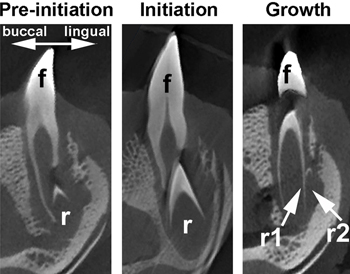 As humans, our bodies have the ability to naturally regenerate both skin and hair, but we only get two sets of teeth, and that's one set more than many other mammals. Reptiles and fish, on the other hand, have the ability to regrow teeth throughout their lifetime. Though we have guessed that specialized stem cells are involved, the cellular and molecular mechanisms behind tooth renewal in these animals have not been well understood until now. A research team at the University of Southern California's Keck School of Medicine, led by Dr. Cheng-Ming Chuong, has recently published an article in PNAS detailing their study into the regrowth of alligator teeth. They chose a crocodilian model because the dentition is well-organized and implanted in sockets of the dental bone, similar to that of mammals (if more extensive) yet with the capacity for renewal. Contributors to the research included colleagues in Georgia, China, and the Louisiana Department of Wildlife and Fisheries, who presumably provided the live research subjects.
As humans, our bodies have the ability to naturally regenerate both skin and hair, but we only get two sets of teeth, and that's one set more than many other mammals. Reptiles and fish, on the other hand, have the ability to regrow teeth throughout their lifetime. Though we have guessed that specialized stem cells are involved, the cellular and molecular mechanisms behind tooth renewal in these animals have not been well understood until now. A research team at the University of Southern California's Keck School of Medicine, led by Dr. Cheng-Ming Chuong, has recently published an article in PNAS detailing their study into the regrowth of alligator teeth. They chose a crocodilian model because the dentition is well-organized and implanted in sockets of the dental bone, similar to that of mammals (if more extensive) yet with the capacity for renewal. Contributors to the research included colleagues in Georgia, China, and the Louisiana Department of Wildlife and Fisheries, who presumably provided the live research subjects.
[Photo courtesy of Wikipedia: American Alligator (Alligator mississippiensis)]
According to Dr. Chuong, from a USC press release:
“Ultimately, we want to identify stem cells that can be used as a resource to stimulate tooth renewal in adult humans who have lost teeth. But, to do that, we must first understand how they renew in other animals and why they stop in people.”
In fact, humans do have one of the crucial requirements for tooth renewal, namely, a band of epithelial tissue called the dental lamina. It is in this dental laminae of the alligator, researchers discovered, that the stem cells most likely reside. According to study co-author Randall B. Widelitz, also a pathologist at USC:
“Stem cells divide more slowly than other cells. The cells in the alligator’s dental lamina behaved like we would expect stem cells to behave. In the future, we hope to isolate those cells from the dental lamina to see whether we can use them to regenerate teeth in the lab.”
It was through the use of multiple mitotic labeling and microscopic imaging that the team was able to map three developmental phases of alligator tooth growth, each involving a functional tooth (f), replacement tooth (r) and dental lamina, as illustrated in the image below:
[Image courtesy of USC]
In addition to observing tooth regrowth, the researchers also discovered novel cellular mechanisms by which the tooth unit develops in the embryo, as well as molecular signaling that speeds growth of replacement teeth when functional teeth are lost prematurely. The next step is to study these molecular networks to understand how they differ from our own. The research project was funded through three NIH grants. Drs. Chuong, Widelitz, and their regenerative biology laboratories were the subject of an earlier blog of ours, Stem Cell Research Meets Regenerative Biology in USC Hair-and-Feather Labs. Both investigators have their labs in the Hoffman Medical Research Building.
Biotechnology Calendar, Inc. will be holding its 8th annual USC BioResearch Product Faire FrontLine event on the Health Sciences campus October 9, 2013. This professional show is an excellent opportunity for life scientists and lab equipment specialists to come together and discuss lab technologies to make every lab run at its best. The USC Health Sciences event is one of three BCI tradeshows held over a three-day period in the greater Los Angeles area:
- 10/08/2013 -- 13th Annual BRPF event, UC Irvine
- 10/09/2013 -- 9th Semiannual Front Line event, University of Southern California, Health Sciences Campus
- 10/10/2013 -- 32nd Semiannual BVS event, UCLA
For more information on exhibiting at USC Health Sciences, click the button below. Explore our website and see the complete 2013 Show Schedule, then give one of our sales associates a call.



